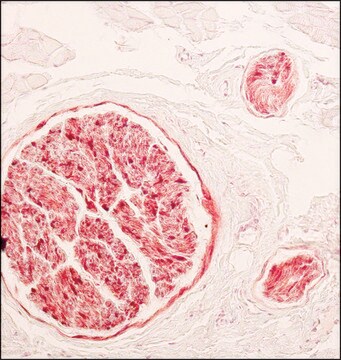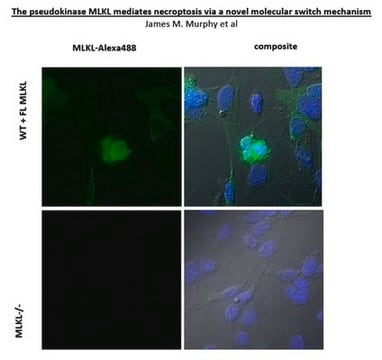SAB4200671
Anti-S-100 (β-Subunit) antibody, Mouse monoclonal
clone SH-B1, purified from hybridoma cell culture
Synonym(e):
Monoclonal Anti-S-100 (β-Subunit) antibody produced in mouse, NEF, S100, S100-B, S100beta
About This Item
Empfohlene Produkte
Biologische Quelle
mouse
Qualitätsniveau
Antikörperform
purified from hybridoma cell culture
Antikörper-Produkttyp
primary antibodies
Klon
SH-B1, monoclonal
Speziesreaktivität
cat, rabbit, porcine, bovine, rat, human
Konzentration
~1 mg/mL
Methode(n)
immunohistochemistry: 1.5-3 μg/mL using immunoperoxidase labeling of pronase digested, formalin-fixed, paraffin-embedded sections of rabbit tongue.
Isotyp
IgG1
Versandbedingung
dry ice
Lagertemp.
−20°C
Posttranslationale Modifikation Target
unmodified
Angaben zum Gen
human ... S100B(6285)
Allgemeine Beschreibung
Immunogen
Anwendung
- immunohistochemistry
- enzyme linked immunosorbent assay (ELISA) (Ca2+ ion independent)
- immunocytochemistry
- immunoblotting
- dot blot
- immunohistochemistry.
Biochem./physiol. Wirkung
Haftungsausschluss
Not finding the right product?
Try our Produkt-Auswahlhilfe.
Lagerklassenschlüssel
10 - Combustible liquids
Flammpunkt (°F)
Not applicable
Flammpunkt (°C)
Not applicable
Analysenzertifikate (COA)
Suchen Sie nach Analysenzertifikate (COA), indem Sie die Lot-/Chargennummer des Produkts eingeben. Lot- und Chargennummern sind auf dem Produktetikett hinter den Wörtern ‘Lot’ oder ‘Batch’ (Lot oder Charge) zu finden.
Besitzen Sie dieses Produkt bereits?
In der Dokumentenbibliothek finden Sie die Dokumentation zu den Produkten, die Sie kürzlich erworben haben.
Unser Team von Wissenschaftlern verfügt über Erfahrung in allen Forschungsbereichen einschließlich Life Science, Materialwissenschaften, chemischer Synthese, Chromatographie, Analytik und vielen mehr..
Setzen Sie sich mit dem technischen Dienst in Verbindung.








